

Abaia. Adapa. Adapa, the first of the Mesopotamian seven sages, was a mythical figure who unknowingly refused the gift of immortality.
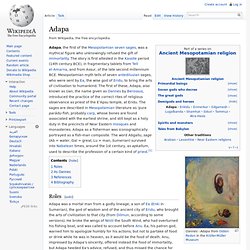
The story is first attested in the Kassite period (14th century BCE), in fragmentary tablets from Tell el-Amarna, and from Assur, of the late second millennium BCE. Mesopotamian myth tells of seven antediluvian sages, who were sent by Ea, the wise god of Eridu, to bring the arts of civilisation to humankind. Adaro (mythology) The Adaro were malevolent merman-like sea spirits found in the mythology of the Solomon Islands.[1] Adaro is a unique creature that lived in the Pacific Ocean.
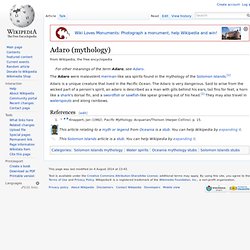
The Adaro is very dangerous. Said to arise from the wicked part of a person's spirit, an adaro is described as a man with gills behind his ears, tail fins for feet, a horn like a shark's dorsal fin, and a swordfish or sawfish-like spear growing out of his head.[1] They may also travel in waterspouts and along rainbows. ^ Jump up to: a b Knappert, Jan (1992). Akkorokamui. Ainu reverence of this monster has permeated into Shintoism, which has incorporated Akkorokamui as a minor kami.
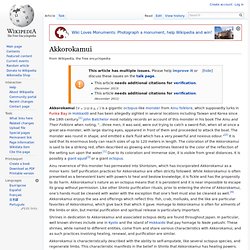
Self purification practices for Akkorokamui are often strictly followed. While Akkorokamui is often presented as a benevolent kami with powers to heal and bestow knowledge, it is fickle and has the propensity to do harm. Akkorokamui’s nature as an octopus means that it is persistent and it is near impossible to escape its grasp without permission. Like other Shinto purification rituals, prior to entering the shrine of Akkorokamui, one’s hands must be cleaned with water with the exception that one’s feet must also be cleaned as well.[4] Akkorokamui enjoys the sea and offerings which reflect this: fish, crab, mollusks, and the like are particular favorites of Akkorokamui, which give back that which it gave. Homage to Akkorokamui is often for ailments of the limbs or skin, but mental purification and spiritual release is particularly important. Amabie. The tile engraving which portrayed the figure of Amabie in Edo era.

Amabie (アマビエ) is a legendary Japanese mermaid who, it is said, came from the sea and prophesied either an abundant harvest or an epidemic. There are similar mermaids related to her; Amabiko (アマビコ?) Atargatis. Atargatis /əˈtɑrɡətɨs/ or Ataratheh (/əˈtærəθə/; Aramaic: ‘Atar‘atheh or Tar‘atheh) was a Syrian deity, the chief goddess of northern Syria[1] (Michael Rostovtzeff called her "the great mistress of the North Syrian lands"),[2] Ctesias also used the name Derceto for her.[3] and to the Romans as Dea Syriae ("Syrian goddess").

Primarily she was a goddess of fertility, but, as the baalat ("mistress") of her city and people, she was also responsible for their protection and well-being. Bahamut. Bahamut or Bahamoot (/bəˈhɑːmuːt/ bə-HAH-moot; Arabic: بهموت Bahamūt) is a vast fish that supports the earth in Arabian mythology.[1][2] In some sources, Bahamut is described as having a head resembling a hippopotamus or elephant.[3] Overview[edit] In Arabic myth, Bahamut is a giant fish acting as one of the layers that supports the earth.[1] In Jorge Luis Borges' Book of Imaginary Beings, Bahamut is "altered and magnified"[2] from Behemoth, and described as so immense that a human cannot bear its sight; "[all] the seas of the world, placed in one of the fish's nostrils, would be like a mustard seed laid in the desert.
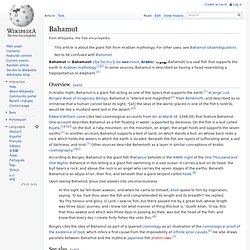
Bake-kujira. The Bake-kujira (化鯨?
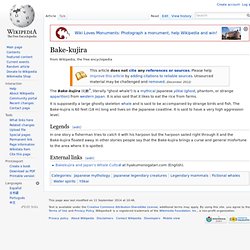
, literally "ghost whale") is a mythical Japanese yōkai (ghost, phantom, or strange apparition) from western Japan. It is also said that it likes to eat the rice from farms. It is supposedly a large ghostly skeleton whale and is said to be accompanied by strange birds and fish. The Bake-kujira is 60 feet (18 m) long and lives on the Japanese coastline. It is said to have a very high aggression level. Legends[edit] In one story a fisherman tries to catch it with his harpoon but the harpoon sailed right through it and the Bake-kujira floated away. External links[edit] Bakekujira and Japan's Whale Cults at hyakumonogatari.com (English). Bishop-fish. The sea bishop or bishop-fish was a type of sea monster reported in the 16th century.
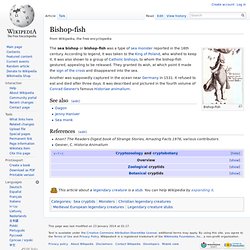
According to legend, it was taken to the King of Poland, who wished to keep it. It was also shown to a group of Catholic bishops, to whom the bishop-fish gestured, appealing to be released. Ceasg. Ceffyl Dŵr. Ceffyl Dŵr is a water horse in Welsh folklore, similar to the Kelpie in Scotland.[1] The book Folk-lore and Folk-tales of Wales by Marie Trevelyan states that the Ceffyl Dŵr can shape shift and even fly, though this varies depending on where you are in Wales.
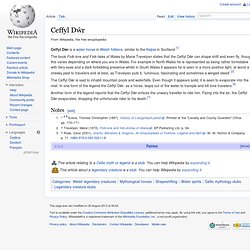
For example in North Wales he is represented as being rather formidable with fiery eyes and a dark forbidding presence whilst in South Wales it appears he is seen in a more positive light, at worst a cheeky pest to travelers and at best, as Trevelyan puts it, 'luminous, fascinating and sometimes a winged steed'.[2] The Ceffyl Dŵr is said to inhabit mountain pools and waterfalls. Even though it appears solid, it is seen to evaporate into the mist. Dagon. A conjectured colored engraving of Dagon, the "fish-god.
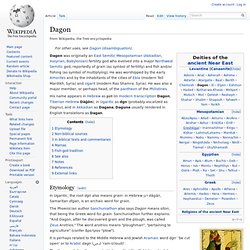
" His name appears in Hebrew as דגון (in modern transcription Dagon, Tiberian Hebrew Dāḡôn), in Ugaritic as dgn (probably vocalized as Dagnu), and in Akkadian as Dagana, Daguna usually rendered in English translations as Dagan. Etymology[edit] In Ugaritic, the root dgn also means grain: in Hebrew דגן dāgān, Samaritan dīgan, is an archaic word for grain. The Phoenician author Sanchuniathon also says Dagon means siton, that being the Greek word for grain. Sanchuniathon further explains: "And Dagon, after he discovered grain and the plough, was called Zeus Arotrios. " It is perhaps related to the Middle Hebrew and Jewish Aramaic word dgnʾ 'be cut open' or to Arabic dagn (دجن) 'rain-(cloud)'.
Each-uisge. History[edit] The each-uisge, a supernatural water horse found in the Highlands of Scotland, is supposedly the most dangerous water-dwelling creature in the British Isles. Encantado. In Brazilian folklore, Encantado (Portuguese pronunciation: [ẽ ȷ̃kɐ̃ˈtadu] or [ ĩːkɐ̃ˈtadu] "enchanted one") is a term for mythical creatures comparable to fairies of European folklore, such as the Enchanted Moura. The term in Brazil is used for creatures who come from a paradisiacal underwater realm called the Encante (IPA: [ ĩˑˈkɐ̃tʃi]). It may refer to spirit beings or shapeshifting snakes, but most often it designates dolphins with the ability to turn into humans. Although belief in them is starting to wane, there are still plenty of South Americans who believe in their existence ardently, and claim to have seen and interacted with them, or even that they are related to them. Enki. A large number of myths about Enki have been collected from many sites, stretching from Southern Iraq to the Levantine coast.
He figures in the earliest extant cuneiform inscriptions throughout the region and was prominent from the third millennium down to Hellenistic times. Fiji mermaid. P.T. Barnum's Feejee mermaid from 1842. Finfolk. Fish-man. Giglioli's Whale. Giglioli's Whale (Amphiptera pacifica) is a purported species of whale observed by Enrico Hillyer Giglioli. Glaucus. Glaucus and Scylla Glaucus (Γλαῦκος, gen: Γλαύκου) was a Greek prophetic sea-god, born mortal and turned immortal upon eating a magical herb. Grindylow. Grindylows are said to grab little children with their long sinewy arms and drown them if they come too close to the water's edge.[4] Grindylows have been seen as a bogeyman used as a ploy to frighten children away from pools, marshes or ponds where they could drown.[5] Popular culture[edit] Grindylows appear in the Harry Potter books and films where they live in the lake near Hogwarts.
Iara (mythology) Iara was a beautiful young woman, sometimes described as having green hair and light skin, connected to a freshwater water body[clarification needed] (the Tupi word y did not have a distinct meaning, being used in general for any such place) who would sit on a rock by the river combing her hair or dozing under the sun. When she felt a man around she would start to sing gently to lure him. Once under the spell of the Iara a man would leave anything to live with her underwater forever, which was not necessarily a bad thing, as she was pretty and would cater for all needs of her lover for the rest of his life. Iaras are immortal (like the nymphs of Greek mythology), but her lovers do age and die, which means that they live most of eternity alone.
Ika-Roa. Isonade. Jenny Greenteeth. Kappa (folklore) Kelpie. Kraken. Matsya. Melusine. Mermaid. Merman. Merrow. Namazu (Japanese mythology) Neck (water spirit) Ningyo. Peg Powler. Peng (mythology) Pincoy. Rusalka. Salmon of Knowledge. Sea monk. Selkie. Shachihoko. Shen (clam-monster) Siren (mythology) Sirena chilota. Triton (mythology) Umibōzu. Undine. Water spirit. Yacuruna.